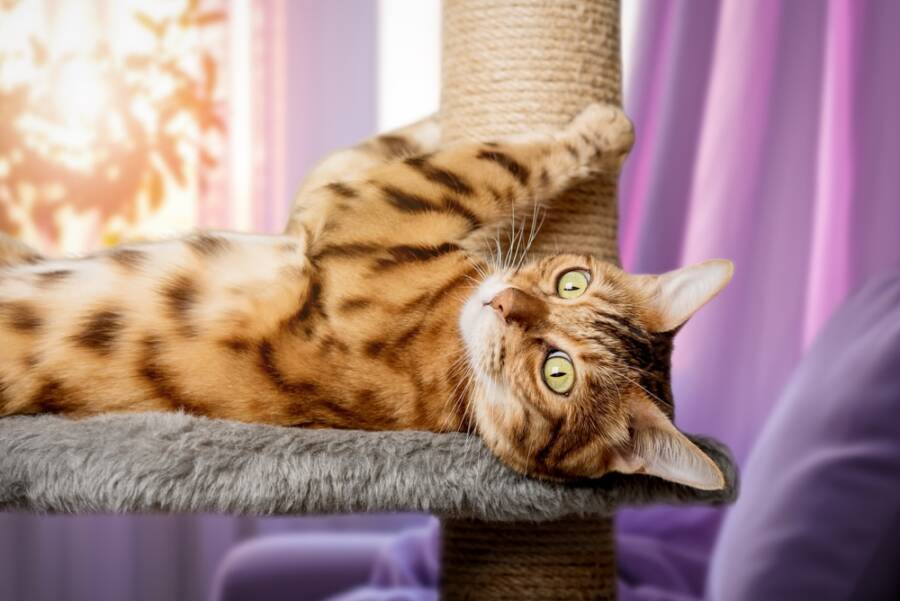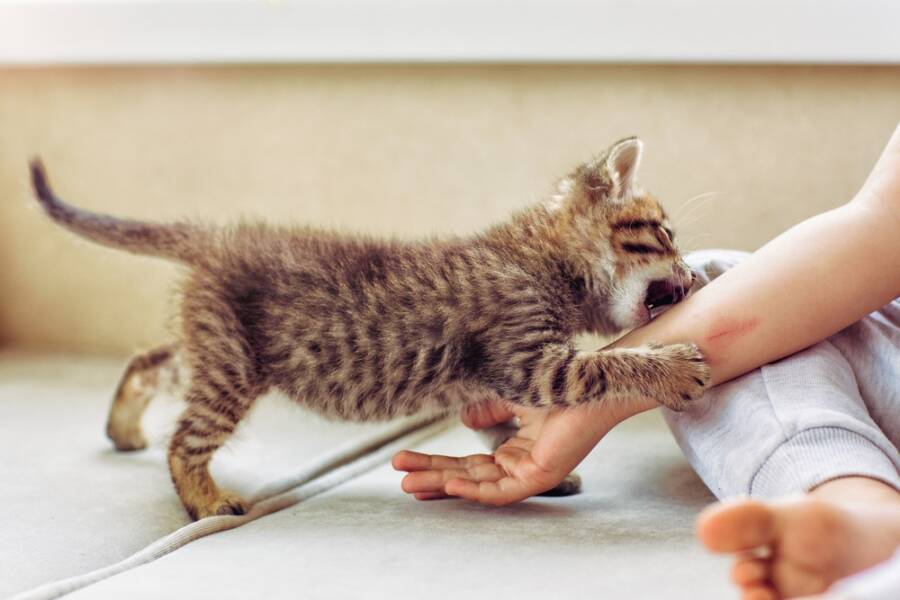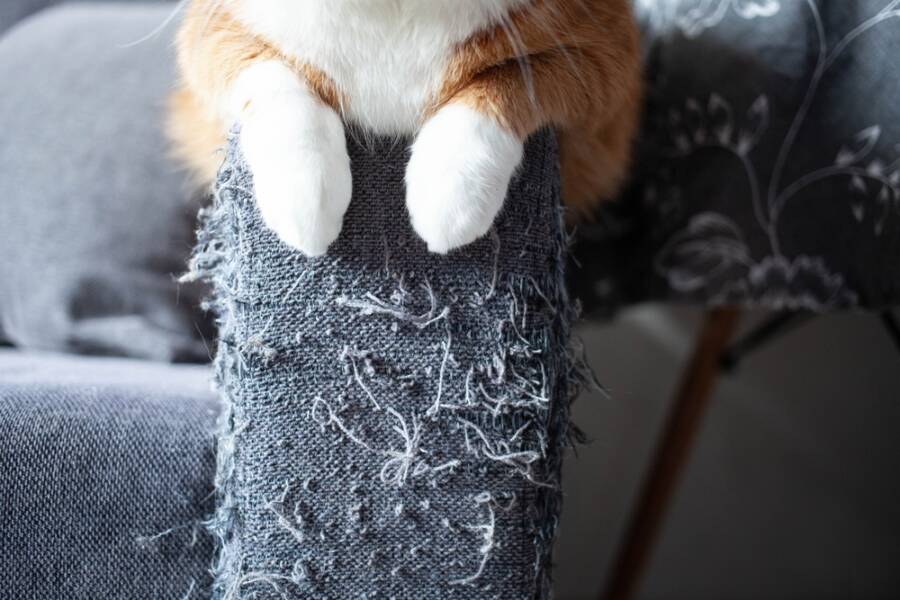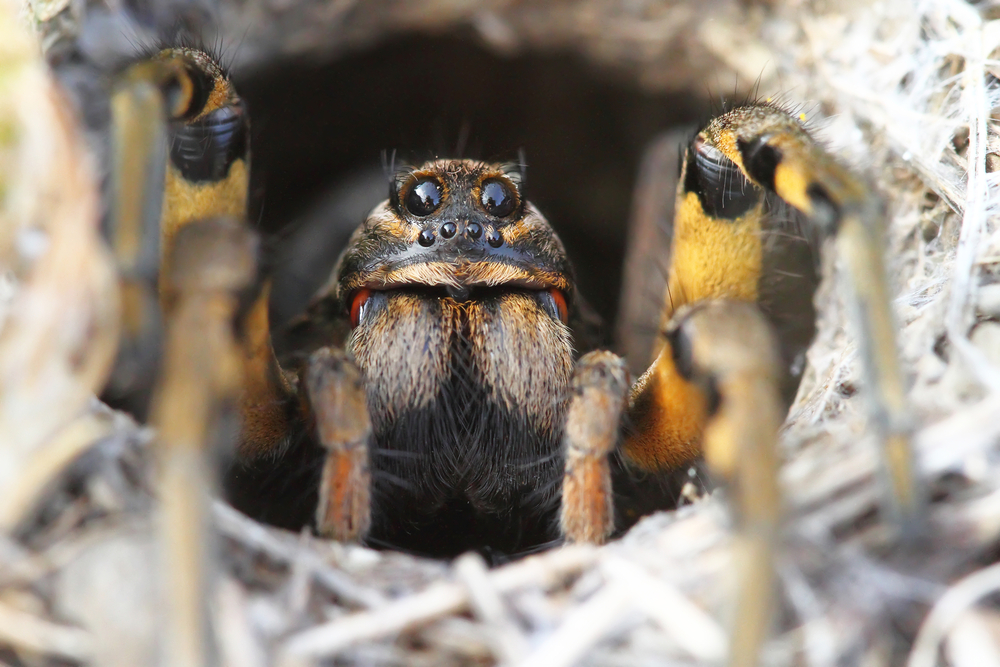How can you deal with your cat’s scratching behavior?
Kittens often bite and scratch while they’re playing and become overexcited. This behavior is natural to cats and isn’t a sign of fear or hostility (most of the time), but if left unchecked, it can turn into a serious issue. This is particularly true when your cat’s playmate is a young child.
The good news is that, in most cases, it’s fairly easy to avert scratching behavior and train kittens in this regard. But first, let’s find out why your cat might be prone to biting and scratching.
Usually, cats scratch and bite in play. This is how they test boundaries, learn to socialize, and just have fun. However, in some cases, a biting or scratching behavior can be a sign that your feline is angry, frightened, or in pain.
If someone other than yourself is complaining about the cat’s behavior, keep an eye on the interaction between that person and the kitten. Perhaps that person is somehow triggering your cat without realizing it.
Also, while some cats are comfortable with being touched on any part of the body, others can be protective of sensitive spots like the paws, face, and stomach. Make sure that your cat’s scratching behavior isn’t related to something that it finds distressing. For instance, is it scratching only with certain people, in certain locations in the house, or around certain animals? If that’s the case, you may want to investigate the possibility of fear.
When in doubt about the reason for your kitten’s biting or scratching behavior, make an appointment with your veterinarian.
Now, let’s talk about how you can help your cat stop scratching and biting.

1. Redirect to a scratching post
Scratching is a natural behavior for cats. They all need a scratching post to mark their territory and stretch their claws. When playing, your feline may use their claws as pouncing and hunting practice—play aggression is normal!
However, if this practice is on you, work to redirect your cat to their scratching toys or post every time the claws come out.
You can recognize when your feline is planning to scratch and pounce by their posture—tail moving back and forth, ears flat to the head, and dilated pupils are all signs of an incoming cat attack.
Training your cat to use their scratching post should be another important part of their lessons. If you have more than one kitten, make sure every cat has access to at least one scratching post each to keep claws in check. Amazon has a bevy of options to choose from, so it’s worth taking a look!
2. Focus their playful energy on toys, not hands
Excited, playful cats may want to grab onto your feet and hands, but it’s important to teach them that they can only play like this with toys. Otherwise, as they become bigger, their biting and scratching behavior may cause accidents and end up hurting you.
This being said, next time your playful furry companion jumps, chews your hands, or jumps at your ankles, react by saying a sharp “no!” so they know this kind of behavior isn’t allowed. Then, redirect them to a toy and stop playing with them for a few minutes.
To reinforce the “toys, not hands” rule, never use your hands or feet as cat playthings. Instead, always make sure to use a toy—ideally, one you hold at a distance from your body, such as stuffed toys, balls, or feathers on a string.
3. Use your voice
Your voice can be a great help in letting your four-legged friend know how you feel. To stop biting and scratching behavior, never encourage it. Say a sharp “ouch!” or “no!” command whenever your kitten nips you.
Your authoritative voice, combined with ignoring unwanted behavior, can reinforce that you’re unhappy. Don’t get us wrong; you shouldn’t shout at your cat. But make sure to let them know that you disagree with any sign of scratching or biting.
Never lose your temper, and always use a calm tone. Your furry friend won’t understand any better if you raise your voice, and an angry reaction from you may cause your kitten to become more fearful and nervous, which will worsen their scratching behavior.
Once you let your cat know that scratching and biting aren’t OK, wait a few minutes, then resume play. Always use your voice to reward good behavior, and stop whenever your cat gets overexcited or too rough.

4. Stop play and ignore biting or scratching behavior immediately
If your cat becomes overly aggressive and scratches or bites you a lot (rather than an occasional accidental bite), don’t ignore it, and make sure you teach them that it’s not OK.
When this type of behavior occurs, be sure to stop playing with your kitten immediately. Step away from them and out of striking range, and don’t fuss or reward them with attention.
Walking away from your cat, ignoring them, and giving them a chance to cool down with no interaction (don’t look in their direction or talk to them) for 5–10 minutes is the best method to stop aggressive play and avert biting and scratching behavior.
Make sure you do this every time your kitten becomes aggressive, and they will soon learn that this behavior means that they will be ignored.
It’s best to teach this while your feline is still a kitten, as they’re still in a learning stage of development. For adult cats, this strategy works best with affectionate cats who will miss your attention. Don’t forget that cats respond best to positive reinforcement, so always be patient and stay calm.
Keep reading to discover other ways to stop your cat’s scratching behavior!
5. Check that your cat is healthy
Cats that are in pain may display biting and scratching behavior toward people or other pets in an attempt to avoid movement, touch, or certain activities that might worsen the pain.
If you’ve tried the techniques from above but your kitten is still unusually aggressive, you may want to check with your veterinarian, as there’s a chance your cat might be in pain.
For instance, cats with osteoarthritis may resent having their joints manipulated or touched and may hiss, scratch, or bite in response. Rarely, some cats may continue to display aggressive behavior after once-sore parts of their body have healed to avoid the pain they experienced previously.
6. Play with your cat every day
Routine is important for our felines, and daily play sessions of 10-15 minutes, at least two times a day, can help your kitten bond with you, feel happy and relaxed at home, and avert biting and scratching behavior.
Teaching your cat how to play calmly is an essential part of your journey together, and this involves teaching them not to scratch or bite during play sessions. If you work on dealing with unwanted behaviors and reinforce good ones every day, your cat will soon learn how to be a lovely pet.

7. Avoid reinforcing unwanted biting or scratching behavior
Though it may be tempting to continue playing with your cat after they scratch or bite you, this type of reaction from your part can reinforce that these behaviors are OK. Moreover, if you do this repeatedly, your car may even start to scratch or bite you for more attention.
Instead, always step away and ignore your kitten, as described above. Don’t let your pet know that playing aggressively is the way they can grab your attention.
8. Create a calm environment
Another reason why cats display biting and scratching behavior is because they feel anxious or stressed. To help your feline feel calm, make sure their environment is just right.
It’s important you provide your kitten with enough resources (including hiding spots, access to water, food, litter trays, and scratching psosts) and ensure they have a regular routine for meals and palytimes. Also, try to limit any extra changes or noises in the house.
If you liked our article, you may also want to read 4 Cat Breeds Most Likely to Attack Their Owners.















